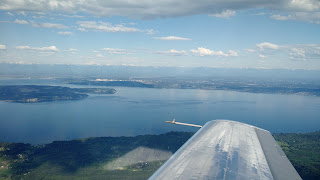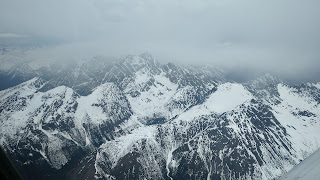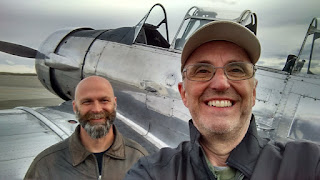I raised my virtual hand, and met Andy Bibber, the owner of Adventure Flight. He runs a tail-wheel only flight school out of Northern California in the winter, and air tours in Fairbanks during the summer. It was time to take the planes north. Sandra agreed to I could have this adventure in place of the three hours with AFT.
 |
| loading up at Pierson |
thing in the morning, but the big radial engine uses a lot of oil, so we are waiting for a shipment to arrive before we can leave. It was supposed to be there on Friday.
 |
| The oil arrives! |
Vancouver WA to Bellingham WA
 |
| The Columbia River, separating Oregon from Washington |
 |
| My home airport from the other side of the Puget Sound |
Bellingham WA to Vancouver BC
 |
| Coal terminal at Vancouver BC |
Vancouver BC to Prince George BC
Even though dark was rapidly approaching we decided to press on over the mountain range between us and Prince George. It is rugged harsh terrain. I would not want to go down in there. It is beautiful, but intense.
We climbed out to 10,500 feet. This was the first real demonstration of the power of the plane’s 600 horsepower R-1340 engine. It wasn’t even struggling at 10,500 feet. In level cruise with a bit of a tail-wind we were making 175 to 180 knots over the ground. Big growly radial engine, eating sky ahead and spraying oil out behind.
Flying the SNJ in the dark allows us to see the exhaust flame's reflection off of the wing joint fairing and adjust the fuel air mixture by color.
At 10:00 PM that night we were lining up for my third T-6 landing. I bounced once, and then pinned the main wheels on the runway. With the heavy airframe, the high approach speed, and the ineffective brakes, I rolled past my turn off. We turned around on the runway, taxied back, and shut the plane down at Esso Aviation for the night. My first landing in Canadian Province, and even better, my first landing in a foreign country.
Prince George was having some big to-do so there were lots of big 4x4 trucks. I think one of the mills or factories or something had gone out of business and there was an equipment auction scheduled for the next day. For a small town so far north, in the middle of what seemed like nowhere, this is a pretty lively city!
 |
| Prepping for our morning departure |
"Ten." I replied.
"Is it normal for it to need that much oil?" He asked.
"Yeah, it uses about three quarts an hour."
Look of shock. "And the hydraulic fluid?"
"Yep. It leaks somewhere."
The Lear pilot pressed on. "Where does it go? Why does it leak?"
"Look," I said, "The plane is 70 or 80 years old. When you are that old, you are going to leak too."
The other Learjet pilot and the FBO staff laughed at the poor guy.
Prince George BC to out-of-choices.
We had been watching a weather front moving in from the west, and the edge of it was producing scattered snow showers along our path towards Dease Lake. We took off into clear skies and settled into a cruise at 8,500 feet.
Far in the distance we could see a small knot of clouds on the horizon, but space on either side. We flew on, aiming for the left side of the clouds ahead. We passed the first small, isolated snow shower on our right. We began working our way north and west, but soon our route was blocked at we made a 180 degree turn back out. We flew northeast finding some more openings, but soon that was blocked, and we went back northwest. Blocked again. We were not getting around the snow showers, and our fuel is limited. We radioed Dease Lake to check the weather and found no encouraging reports. Our only option was to climb above the snow showers and divert to Watson Lake. It was further, and would tax our fuel supply, but the weather was favorable there.
 |
| Snow making things tougher |
And commit we did. North to Watson Lake YT we pressed on. Up we went. With the plane pointed up hill, the fuel sloshes to the rear of the tank, and pick-up in the front of the right main began to suck air and the engine sputtered. This was new for me. I’ve never had a tank run dry in a plane. A quick switch to the left main had those 600 horsepower pulling us easily up to 14,000 feet to clear the clouds ahead.
We went GPS direct to Watson Lake skimming across the clouds, we switched back to the right main where the fuel had sloshed back forward to give us another 10 or 15 minutes of flying. We were making good time with the GPS showing ground speeds between 175 and 180 kts, and finally the right main went completely dry. So back to the left main tank we went, and pressed on. We were still on the left main, and the reserve tank would give us about half an hour of flying time, and the GPS was showing about 40 minutes to the airport. So as long as we had 15 or 20 minutes of fuel in the left main, we would make the airport. Plus we can glide a long way from 14,000 feet.
But this is not good. We had flown ourselves into a situation where we had no alternates. Either this worked or... I’d prefer to not think about it.
 |
| Watson Lake's terminal |
We didn’t want to spend any time maneuvering so we lined ourselves up for a straight in approach to the runway, dropped the gear, and I plopped it hard onto the runway again. We were both glad to be on the ground next to a gas pump.
Watson Lake to Whitehorse
 |
| The Yukon River |
Whitehorse to Fairbanks
 |
| Right Downwind departure from Whitehorse |
And it was cold. I had on wool socks, jeans, 2 shirts, a flight suit, and a pair of gloves. There is no heat in this plane. It mostly warms from the sun shining through the “greenhouse canopy.” But little sun we were getting was not keeping up with the cold leaky cockpit. My hands were starting to ache from the cold. I would sit on one and fly with the other, and then trade to warm up the cold one. I would tuck them into my armpits or press them up on my body to get them warm. My toes were getting stiff. I was getting stiff.
 |
| Note the line on the hill. Left side Canada, Right side Alaska |
 |
| Tanana River and the Trans-Alaska Pipeline |
At the edge of the TRSA
The arrival to the Fairbanks area routed us through several Military Operation Areas, and two military airports. About 30 miles south east we called up the Terminal Radar Service Area (TRSA) controllers. TRSAs are odd things. They provide radar services for arrivals into the areas, but pilot's participation is optional. To our right we passed Eielson Air Force Base, and then Fort Wainwright / Ladd Army Airfield.
 |
| The planes by the float pond reminded me of an airplane homeless encampment |
I had to make a couple passes at the runway to figure out the layout of the runways, and at first I lined up on a taxiway to the left of the ski strip, and by the time I got lined up on the runway, I was behind the plane and bounced it, I slammed the power back forward and went around for a second try. On the second pass, I managed to keep the left wing low for the crosswind, and still set the plane down hard -- again. With the power off and the tail pinned down, the end of the runway closing fast, I applied the marginally effective brakes, and heard Andy in my headsets saying "We are going off the end!" Then I stood on the brakes. With my legs extended straight out, and my back pressed hard against the back of the seat, I got the plane stopped feet from the threshold and turned off to the left towards the general aviation (GA) ramp.
 |
| On the ground in Fairbanks, clear of customs. |
We taxied back to the GA ramp where Andy’s friends came out to greet him. Inside we filled out the last of our log books, Andy signed off my Biennial Flight Review (BFR), and I booked the next Delta Airlines flight back to Seattle.
EPILOG and Full Photo Album
One new friend, two days in the SNJ-4, 11.9 hours of flying, seven gallons of oil, gasoline measured in liters, 24 more months of flying on one BFR, two new provinces, one new country, and one new state. 34 down, 16 to go. One AWESOME adventure.
Full photo album.
 |
| Checking off Alaska. 34 down 16 to go |

